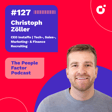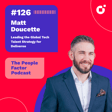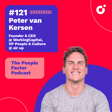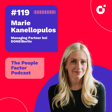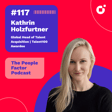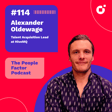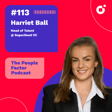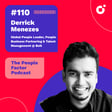Introduction and Hiring Goals in Germany
00:00:07
Speaker
Hey, Liz. Another day, another episode, right? Yes, hello. and I just had an interview with Katrin Holzfordner. It went live in the past podcast episode.
00:00:19
Speaker
And um there were so much things that we could still talk about. Funnels. ah love this topic. I know. and So I thought that we just spontaneously continue and see how could you plant to hire 50 sellers in Germany in half a year and the organization did 25 in the past six months. So the task is to double the amount of hires, but not necessarily double the amount of capacity.
Strategies for Doubling Hires Without Doubling Capacity
00:00:57
Speaker
um I just share this We discussed so far. yeah So um we have some mock data, which is realistic data. So I saw similar data with our customers with also other companies.
00:01:15
Speaker
um So let's say this is just a real example.
00:01:21
Speaker
five thousand 5,000 candidates for 25 hires, that's 200 candidates processed in order to make one hire. 26 interviews from a recruiter in order to make one hire. 11 hiring manager calls, then let's say a case study and then a final interview.
00:01:41
Speaker
one offer, one hire. For five hires per month, let's say it would be 1,000 applicants a month or candidates, 130 recruiter screens, and so and so forth.
00:01:53
Speaker
And I think what is important and what what you can really grab and then um imagine is 150 candidates processed in a week, 32 interviews from a recruiter, 14 interviews from a hiring manager,
00:02:12
Speaker
10 case studies and role plays and six final interviews in order to make 1.3 offers and one hire roughly. Right. and So that's the data
Prioritizing Roles and Mapping Hiring Timelines
00:02:22
Speaker
we currently have.
00:02:23
Speaker
And nowa now our our task is in six months, how can we make 50 hires? So um
00:02:33
Speaker
what would you do first?
00:02:37
Speaker
I think, um obviously, first of all, look at the capacity that I have currently already um and then see what the hiring plan is and the priorities of the different roles.
00:02:50
Speaker
Because obviously making 50 hires doesn't mean that all 50 are in the same priority. So I think that's the plan and organize the capacity and then start allocating the...
00:03:07
Speaker
I love it. Let's start with that, right? So um how how we can look at the current capacity. Let's say we have, um let's say, past six month
00:03:25
Speaker
And let's say it it stays the same for, I would always start
Maintaining Productivity in Talent Acquisition
00:03:30
Speaker
with one higher, right? I think it's easy. Then we say, okay, um how do we Do this by 25. Then we have the funnel from up And then this was done in six months.
00:03:45
Speaker
ah Past six months total. And then we would just start with month one, month two, and we just map it out for six months, right?
00:03:58
Speaker
Oops, not 15 months.
00:04:04
Speaker
We go to six months and then we see and what we can do. There is usually a ramp up and so on what we should consider, but just out of simplicity, what I do now is i just divide this number by six that we know when everything is ramped up and going. So we don't consider the onboarding and ramp up time here.
00:04:26
Speaker
um We just say we need to continue what we do. It was already running before and we take the snapshot of a fully ramped, productive talent acquisition organization that is just continuing to the to do the work, right? So this is what we are assuming here.
00:04:42
Speaker
um And then we see we need, okay, 850.
00:04:50
Speaker
So we have the data. And now we make it a bit more pretty. and okay this is what we have. So what do we see here? um What I see, okay, four hires a month with five accepted offers.
00:05:07
Speaker
um That's what they currently have. I don't know what the capacity is they're currently having, but we can calculate it.
Improving Candidate Quality and Sourcing
00:05:22
Speaker
um in terms of assumptions do we take? So what do you think a fully ramped recruiter in that organization, um what KPIs would you but do you read out or give them?
00:05:37
Speaker
I think definitely screening numbers. soing And these are like per week, right? Like I would break it down as we did it here. So how many sources per week?
00:05:49
Speaker
How many screen per week? Um, because those are things that are in your control. um Um, and then ideally also like the, like how many hiring manager conversations you have, but they really enter the funnel and get into the conversations. Uh huh.
00:06:06
Speaker
And, um, and then final, like case studies, obviously depending on what the process is, um, then the number of, um, case studies you have or finals, um,
00:06:17
Speaker
um in a month maybe rather than in a week because I think that's a bit more realistic due to planning or availability of candidates or hiring to.
00:06:28
Speaker
Yeah. Okay, and then let's do it exactly like this. I like it. You you can go down different routes, but I'm i'm pretty much on on your end. So first we start with quantifying.
00:06:39
Speaker
yeah um What do you say? okay that's 850 month. When we divide by like this. it be 212. it's two hundred twelve let's just do it like this
00:06:55
Speaker
and so it would be two hundred twelve And this is just a pure number.
00:07:05
Speaker
But I think it's also important, like just for the sake of this example now, also to mention that obviously if you start building up your funnels, that these numbers can change because, you know, we don't have to consistently do 213 candidates. Maybe if the quality of your source candidates obviously goes through just, you know, like I think also for for the people who will be doing this, it's also important to know.
00:07:30
Speaker
Yeah. that the the the source number can obviously change the multiple you have in the pipeline, right? um What I would do here, we now just assumed what was happening here.
00:07:43
Speaker
But what what is really realistic when we say realistic for one person? Yeah. yeah um Let's say sourced is done by a sourcer.
00:07:58
Speaker
A dedicated Sorsa. What would a Sorsa or let's do it like this. um Realistic data. um Sorsa recruiter
00:08:14
Speaker
from one FTE. Yeah. by a sourcer, a recruiter, let's say hiring manager. Yeah.
Structuring Interviews and Panel Planning
00:08:24
Speaker
That is also having a regular day job.
00:08:26
Speaker
Yeah. um I would just break it down because I think being granular here is maybe too complex for many of the organizations, for many of the people that just do the planning, but that's where at the end the bottlenecks also come, right? So a full-time sourcer could deliver um How much source candidates weekly in sales are in Germany?
00:08:50
Speaker
Yeah. I mean, if they're slowly as slowlyle doing sourcing and nothing else, then I think they can absolutely do like way more. Like I think even up to like 500 week. Yeah.
00:09:02
Speaker
ah we um If it's a full-time recruiter that also needs to do interviewing. Let's assume it's easy. full-time recruiter could do 250, not sorry, 250, 25 screens, but I would always go for 20 per week.
00:09:26
Speaker
Yeah. um But when doing 20 screens, how much you can still source? Yeah, it is quite time consuming also, obviously, depending on the length of the interview, right? And then you have internal interviews and, you know, debriefs and also, so I think putting this all into consideration, i think maybe like 50 to 70 realistically.
00:09:56
Speaker
Realistically, right? Realistically. If you have a qualitative source, right? Like this is also important because you have to take the time to go through the profiles, really look at what's relevant.
00:10:07
Speaker
You can always add numbers, but we're talking about qualitative sourcing. Let's assume now a recruiter that is doing 20 interviews needs to also manage um market... um So, so displaying, um, what the market gives you versus the expectations you have. So setting up expectations, focusing really on stakeholder management with an excellent perspective, I would maybe not say let the recruiter source as well. When we have a sourcer full time, assume, assumed that the sourcer can deliver 500 candidates. Right.
00:10:43
Speaker
So, um, I would say they should not source. They should focus on interviewing and really managing the hiring team. I think that is way more important when you have a setup like this than also just going down on top of funnel volume because we don't want to increase the volume. We want to increase the quality and the conversion rates and lower the volume by doing more with same capacity, right? So that's actually the goal here.
00:11:07
Speaker
um So but what could we expect from a full-time hiring manager that already last year Yeah. Hire 25 sellers. So the organization might be big. yeah um Let's assume the organization is bigger than 25 because otherwise you would not add 25. Let's say it's already 50 and you need to add another 50 to go to 100, let's say.
00:11:29
Speaker
um How many interviews a week can a hiring manager do? What can we expect?
00:11:36
Speaker
Well, I mean, this is where the but first bottlenecks start for me, to be honest, because it's really different in different organizations, like the way hiring managers are involved. and And again, I'm just mentioning this because this is important and we don't want to just um neglect that.
00:11:52
Speaker
But I think they could do they could try at five, I guess, or like
Weekly Activity Plans for Recruiters and Managers
00:12:00
Speaker
me three to five, depending on how urgent the role is and how much they take hiring seriously as well. Let's say they need to really double, hiring is a priority.
00:12:11
Speaker
Yeah. Then I think they should really try to aim for five a week. Okay. And we need 12. So we need two hiring managers or even 2.5. two point five yeah Or let's make it simple. Let's say six, because six is exactly 12 divided by two.
00:12:26
Speaker
Yeah. Okay. Yeah. I mean, ideally you would also have like a hiring, and like an interview panel, right? Where it's ideally not just on one person and there would be some- A hundred percent.
00:12:36
Speaker
Yeah. That's also important for this number to reach, right? What I would do, I'm fully with you on the monthly, but let's for now go on weekly because then it's just more comparable when you we when we do the capacity planning initially. So then we would say um final cases, okay, VP sales, let's say.
00:12:59
Speaker
Let's say there is a VP sales that does the final. um How many can a VP sales do? Wow. Do you want the realistic number here as well? and Yes, yes. We are talking realistic numbers.
00:13:11
Speaker
Yeah. I think they do maximum two, to be honest, realistically from my experience in a week.
00:13:21
Speaker
But this is obviously not what we're supposed to do. In cases? Sorry? In cases? yes
00:13:31
Speaker
I have done four cases a week. Okay. I like the numbers. um The resources they do zero. So let's just fill this up, right? That we know what is happening here.
00:13:46
Speaker
Because we could even say that the VP sales or not the VP sales, but maybe some hiring
Optimizing the Hiring Funnel
00:13:50
Speaker
managers also need to source, right? this could also happen sometimes when you really need to go down, and it's critical.
00:13:57
Speaker
um But let's say we we don't assume this here. So this is actually that the activities, KPIs
00:14:06
Speaker
in activities, yeah? What we want to see weekly. Let's say weekly. Okay. and Liz, I see a problem.
00:14:18
Speaker
yeah we We need 20 finals per week. yep No, per month. Sorry. we we We divided that by four. Now we need to make it more realistic. so Okay. We need per week, eight cases, five finals. So we need two VPs during the final interviews.
00:14:39
Speaker
but maybe Do you think the organization has two VPs? No, not two VPs, but I think, and this is where you can kind of overcome the first bottleneck, is really getting more interviewers into the hiring, you know? So it's not just one hiring manager or it's not just one VP, but it could be A director, you know, that can also just assess someone like a VP.
00:15:04
Speaker
um Or they're like three different hiring managers from the same area. Let's say if if we're talking about sales and, um you know, there is sales banking, sales, I don't know, real estate or whatever it is that they all get involved and help and support. to They all have the same...
00:15:22
Speaker
work and the workload. So I think this is how you overcome this issue, which is very realistic and the organizations today.
00:15:40
Speaker
what I would do now
00:15:47
Speaker
I would look at the ah FTEs needed. So what do we need? We need, let's say FTEs needed. Yeah.
00:16:04
Speaker
for that, we need 0.5.
00:16:10
Speaker
Sources, right? Because we need to do 200 week. And the goal for a full-time source would be 500. Yeah. yeah So we need 0.5 sources.
00:16:23
Speaker
Recruiters, we need,
00:16:34
Speaker
Then hiring manager calls 612. six twelve So we need two hiring managers or sales managers. We also need to, now the question is, Liz, can the same hiring managers that do the hiring manager calls also do the case studies?
00:16:57
Speaker
So usually how i would suggest this is that you get one of the hiring managers in it and then either like a peer from the team or like a senior from the team.
00:17:10
Speaker
And if any, if whatever the constellation is from the stakeholder team, for example, and that you have like two to three people in the case, ideally. So then you have a variety of evaluation, but then also a variety of availability.
00:17:27
Speaker
So what you're saying... um
00:17:32
Speaker
That you create basically an interview panel, so it's not just... We need an interviewer pool of at
Evaluating Hiring Strategies and Capacity Planning
00:17:41
Speaker
least four people, let's say, um performing hiring manager calls and cases.
00:17:57
Speaker
Because then we can plan for also two hiring managers. So we need two hiring managers capacity and here two hiring manager capacity, but this cannot be the same hiring manager capacity. So we we need the the capacity for two hiring managers, but we need four people doing this work because if they do the hiring manager calls, they don't have capacity to fit in the cases.
00:18:23
Speaker
Yeah. I mean, yeah. And then we need you have an ah an awareness, obviously, that if you have a high number like this for six months of hiring, then there needs to be more involvement of the hiring teams.
00:18:39
Speaker
Okay. And we have two VP sales interviews that we can do week and five finals. So we would need two VP sales.
00:18:53
Speaker
VP says, but I also think it can be like the director, you know.
00:19:01
Speaker
Yeah, if they exist. So, um but what we need actually two to five or it's two to three here. Let's say we take three here. We are good in negotiation and get a better commitment.
00:19:13
Speaker
And then we have room for just two VP sales or directors because maybe what we can do we can train up one hiring manager who is the senior hiring manager um doing also a VP sales interview so a bit of creativity is always needed right um but let's go with this assumption then we maybe need one VP sales or one director let's say the top decision maker in this organization with the scope plus maybe one deputy or whatever it is.
00:19:41
Speaker
Okay. If it's better, maybe even more people or we can get rid of the final call because this is already good enough, but who knows? Let's go with this assumption. um So what we need is um actually,
00:19:56
Speaker
yeah, two people here, four people here, two people here that delivered 25 hires across the ah across um six months, so four hires per week.
00:20:07
Speaker
Yeah. Also, maybe yes, another suggestion for the finance could be also like a founder, right? Like if we're talking about a startup, so ah they could also get involved. So I guess there's like also vari variety. So you don't need to necessarily just keep it on that level. It could also be higher because they're just as ah as involved or just as keen on hiring people, right? So...
00:20:31
Speaker
okay, Liz, now that the the work starts. We just now know what happened, right? Or let's go with the assumption, but let's say this this really happened. And then it's already a really good running organization if they can manage to get these hires with these resources, right? They're then but well calibrated.
00:20:47
Speaker
They're just productive running. There are no major changes like somebody is getting fired. Somebody is changing jobs. Somebody is leaving the organization. Somebody is disrupting something. This is really just all stable for six months.
00:21:00
Speaker
um yeah So we now assume
00:21:08
Speaker
to double. no So let's say we take, we take, um for we make a forecast,
00:21:26
Speaker
forecast 50. fifty hires. um
00:21:34
Speaker
And we need to double that. I make it different.
00:21:45
Speaker
but we cannot double the capacity. So this is just doubling and doubling the capacity. That's not what we want.
00:21:53
Speaker
Let's say the hiring process for now stays the same. Because I think you also don't really have time in that short period to just change everything. um And now what I would look at now is first the conversion rates.
00:22:16
Speaker
To see what is healthy, what not. Okay. So we have...
00:22:40
Speaker
interview rate, right? So from 10,000 people, 13% gets interviewed. This looks for me like applications. This doesn't look for me like sourcing because usually as sourcing um conversion rate is maybe...
00:22:59
Speaker
I always see an healthy interview booking rate between 7% and 12% for sales hiring in Germany. And let's go with and if a number. Let's go with 1,000.
00:23:10
Speaker
um thousand We say sourced 1,000 interviews. 7% is... and Let's go with the middle of the benchmark with 9%.
00:23:28
Speaker
Then you get 90 interviews out of 1000 candidates. um So out 100, you get nine interviews.
00:23:46
Speaker
I think that they should really do a lot of um way more sourcing um because... But are we talking about the sourcers now or... um attack. um So ah for me, this looks like that there are a lot of kind um applications just processed, right? Because um I don't know if you can
00:24:13
Speaker
source 850 candidates and get 100 calls. I think that's a bit high. Yeah. um These are the numbers, the mock numbers that you've chosen, right? From...
00:24:25
Speaker
Yeah, but it's also quite realistic. So um I would really try to go down here um with the conversion. um So let's say optimized funnel.
00:24:38
Speaker
I would try to go down maybe with half of the candidates.
00:24:47
Speaker
um that you can double the amount of hires um but just also increase um the number of um candidates that are sourced and reached out to versus processing applications but you also then need more candidates. So it's not so easy. I would not start in the beginning, um to be honest. So maybe let's start at the bottom because backwards planning is always better than just forward planning, in my opinion.
00:25:14
Speaker
um So when we look at the offer acceptance rate, I think that's a healthy ratio. What do you think? Yeah. Ideally, yeah. Then let's keep it by 93%. now go to the ah for
00:25:34
Speaker
extended rate from final interviews, that's quite low, right? So I think this should be 80% plus, to be honest.
00:25:48
Speaker
Because the lower the funnel and the lower the conversion rate, the more candidates you should filter out early on and the more expensive in terms of time,
00:25:59
Speaker
resources and then ultimately money is it um to have low conversion rates at the bottom of the funnel. So let's say we need to get this to 80%.
00:26:10
Speaker
I think a lot of calibration needs to happen before um in order to do that.
Adjusting Processes and Role Responsibilities for Realistic Planning
00:26:15
Speaker
And maybe we can even eliminate the interview free step um when the hiring panel is really, really calibrated well.
00:26:26
Speaker
um So we could for this run now, maybe remove the final call with the VP, just making sure that the hiring manager team is really trained well. And when we know that the previous hires of the 25 hires would perform well, um it's a short period of time to judge this, but this would be one thing what I could just, what you could just do because then you need way, way less candidates, right? Removing this step and you could just be way more extensive in the hiring manager screening.
00:26:54
Speaker
then don't need the interview free. You don't need another VP for interviewing and you can still be very um rigorous in the case.
00:27:06
Speaker
Yeah. So let's try to do it.
00:27:10
Speaker
manage a call and this is then the case. And afterwards you get an offer because yeah.
00:27:27
Speaker
ah So this would then be really low. We need to go to 80% after the case study. Then we can maybe even keep it at 70 roughly. um um So, or 66. So two out of three candidates that go for the case study need to get an offer. Okay.
00:27:49
Speaker
You can also go down to 50. I was just about to say, I think my realistic number is more of a between 50 and 60, to be honest. Yeah. um How many people should enter the case study from the hiring manager call?
00:28:08
Speaker
ah we Are we basing this again on the weekly? yes so um
00:28:15
Speaker
Well, ideally you would have each week like minimum three case studies
00:28:24
Speaker
that go to, well, i sorry, are we talking about case study to offer extended? and No, no. Hiring manager calls that convert into a case study. Oh yeah, that would be... o Obviously, if we're talking about the quality, I think it should be ideally... a um just playing all the realistic scenarios in my head. So how many really do go through?
00:29:04
Speaker
how What was the number again that we had put up at the...
00:29:09
Speaker
um Six, right? Six, yeah. Yeah, i think. So four out of six, so it's a bit more than 60%. Yeah.
00:29:18
Speaker
yeah I would take a different logic and say... um We rather have just 50%, but then also we have a higher case study to offer ratio because let's let's be way more rigorous in who putting food to the case study.
00:29:42
Speaker
um And maybe making the hiring manager call way more intense. um And also the recruiter screening. So 43% pass here.
00:29:55
Speaker
um Maybe we can keep it like this. I think it's an okay number. And I would lower this rate that you just talked to 7% of the candidates.
00:30:07
Speaker
um And when we now... multiply this up let's see what we could optimize
00:30:25
Speaker
so this divided by that
00:30:40
Speaker
Okay, so we now need way more candidates because we have um have lower conversion rates on the recruiter side.
00:30:54
Speaker
um So that doesn't really help us, right? So we still have,
00:31:01
Speaker
I think that's not a good optimization. If we stay with 13%, we still 10,000. Yeah. we still need ten thousand
00:31:10
Speaker
If we prove 25% or if we interviewed 25% of the candidates, I think that's way too high. You would have the similar amount of data. So to be honest, what I i see here, i don't think it's really realistic to double the amount of hires with the same capacity, right? Because this is what we try to do here.
00:31:33
Speaker
We had here roughly the same numbers, way less case studies. a bit more hiring manager calls. So we would need to move a lot of capacity towards the hiring manager calls and have a similar amount of recruiter screens.
00:31:48
Speaker
And um let's say we keep this constant, then we would still need 10,000 candidates. So out of the same amount of candidates, we would get
00:32:03
Speaker
the same amount of recruiter screens, more hiring manager calls, Less case studies, yeah but more offers accepted. So what would happen here in this scenario? So um in my opinion,
00:32:19
Speaker
um you would maybe draft out different roles um and ease up the requirements. On certain roles and maybe instead of hiring full time, so endto end to end AE sellers, you may make a split and say, okay, you, you build an organization um that has maybe simpler roles, but I think it's not necessarily easier to hire and SDR versus an AE, to be honest. So that's also not so easy.
00:32:53
Speaker
You would need the same amount of recruiters here.
00:32:59
Speaker
more hiring manager um call capacity. So would maybe need not just two, but maybe three for doing, performing the hiring manager calls. And then you need a third of the case studies, which is good because case studies take longer and take more people. But this is, I think the optimization you should look for and then um offer stays constant because this is a great example.
00:33:22
Speaker
um but So I don't, yeah. I would also like to make point here with the increased hiring manager calls that would also lead to ah longer time to hire, I think, because the availability of hiring managers is usually way more limited than the availability of talent partner or recruiter, right? So and I think this is also then to consider for the six months period that we have given as a Yes.
00:33:53
Speaker
So but what I would say here, I would still go down here, maybe to 9% and 15,000 candidates that should be needed. i think that's, it's just not, you don't really find that. So we didn't analyze
Market Limitations and Resource Requirements
00:34:10
Speaker
this. analyzes For instance, if you just want to hire ah um generalic um a generic salespeople into Berlin,
00:34:18
Speaker
yeah 10,000 profiles exist. And of course, Germany and Berlin is definitely not the same. um But i think if... The requirements, right? That they were stuck in like certain cities with the hybrid... sometimes, exactly. So you you maybe not even have a choice, right? So you need to see what you get out of your funnel. list So I think...
00:34:46
Speaker
you either really need more resources there and and you get them temporarily approved, for instance, or you find a really smart, sharp way in order to increase it. And just with generic data, I think it's not possible to really judge it.
00:35:02
Speaker
um But of course, what you could do, you could say you hire out of a pool if you have a pool. um But that's also tricky, right? It's maybe after a layoff, um you hire back past employees.
00:35:15
Speaker
This is what I could imagine where a conversion rate could look like 25%. um But find so many people that already have been part of your organization laid off and are now boomerang hires.
00:35:29
Speaker
So it's all a bit tricky. and So let's say yeah would really need to go with the same amount, 10,000 people. You're just better in converting and um interviewing and you have to write 10,000 people with a volume. I think it's really tricky.
00:35:49
Speaker
Let's calculate What would this look like?
00:35:56
Speaker
um It would look like this divided by six again.
00:36:18
Speaker
So in theory, we now have the same input of candidates. with the double output of hires by removing one stage and being way more critical at the top of the funnel.
00:36:33
Speaker
The bottleneck, what I still see is there are candidates accessible in that short period of time in order to just double the productivity within, let's say, ah certain a short period of time of six months. You could also argue and say, okay, in six months of hiring 25 people, we had the following three learnings and we implement these three learnings.
00:36:59
Speaker
And this is why we can double the amount with the same input, right? Could be an option. I did not see this really in reality. yeah um Unless the company is really realistically changing a lot of things and are willing to change a lot of things.
00:37:15
Speaker
But usually what is happening here, they just say, hey, we need now more recruiters. We cannot hire for the full year. um So people wise, please come in and add two or three more people.
00:37:26
Speaker
yeah This is actually what's realistically happening. And then you can really get close to this um number. um But often it's then also a delay because it takes time that the organization can really learn.
00:37:38
Speaker
And then you would would maybe plan for nine months and the adaption and change usually takes three months, right? So let's maybe plan for this. Did we say, okay, we either,
00:37:56
Speaker
we just say we plan them out and divide everything by nine.
00:38:04
Speaker
Or I would say we start in the beginning by six and then we go up to nine at some point
00:38:18
Speaker
and see how much we need in total. So if we go, oh, sorry, we need first the nine. This was a mistake. um First three months is on nine and then we are down to six months.
00:38:38
Speaker
So in order to get to 50, when do we have the 50 hires? We have it in month of seven then.
00:38:49
Speaker
So when we just plan for in the beginning, it's a bit similar to what we already did or it's just a small step.
00:39:00
Speaker
um And the change takes two months and after two months of the change, or after three months of the change, you are way more productive. And for four months, you have higher productivity for um three months.
00:39:16
Speaker
You already get a bit more productive, but this takes time. um And um then we would just calculate as well what needs to be done each week by the recruiter or by each person.
00:39:38
Speaker
This an exercise that takes time yeah and you never really can make it right. It's always ah about constraints and asking yourself, what constraints do you believe? Or what?
00:39:52
Speaker
Like one of the constraints is also the time in the year, right? Like when you hire added availability, promotion cycles, summer periods, like all those things also do add.
00:40:05
Speaker
Christmas time also adds to the fact that on how many people are on the market or available and sickness, there's always a time where everyone is sick. So those things also obviously.
00:40:18
Speaker
yeah. needs to be considered too, but we're just talking about assumptions. Yeah. Okay. But let's say this is what we need to deliver then every week or this needs to be delivered every week.
00:40:33
Speaker
um A full-time sourcer.
00:40:39
Speaker
So what do you wouldn int need? Sourcer, recruiter. hiring manager and we removed the VP, right? We don't need that anymore because the hiring managers are trained to do um
00:40:53
Speaker
better work after six months of interviewing already, let's say. And um there is not a big change. So this is um what they need to do on a weekly basis. Not divided by four. This is what they need to achieve.
00:41:10
Speaker
um Then the recruiters divided by, let's say 20. ah Sorry. This by 500. So you need one.
00:41:28
Speaker
um Divided by 25. Now 20 we said in the plan or how how much did we say they can deliver? 20. Yeah. So you would actually need then three recruiters.
00:41:42
Speaker
um And hiring managers could do um five, you said?
00:41:50
Speaker
Six. No, from hiring manager calls. Five of them, we can change it to six, I think. But I do think this is more realistic, to be honest.
00:42:05
Speaker
Five. lets We blend with six, so we need five hiring managers. But they also need to do the case studies.
00:42:16
Speaker
And I would then say plus this divided by,
00:42:33
Speaker
six per week, that's then eight. I would not mix it up. Hiring manager call and hiring manager
00:42:47
Speaker
for the case. And then you have it a bit simpler. You could say
00:42:54
Speaker
have cases for what one person can do.
00:43:07
Speaker
No, two per week we said.
00:43:11
Speaker
Two hiring managers we need for the case we said, yeah.
00:43:15
Speaker
But then they need to do four per week and six of these. Okay. Let's go with the assumptions.
00:43:26
Speaker
Okay. So we need in total hiring manager needed. The question is, do you have that right?
Conclusion and Emphasizing Realistic Planning
00:43:35
Speaker
I was yeah just thinking and like how realistic is it to have five high reminers? My take would be really challenging the plan and prioritize and just maybe do the most critical first and then fade out the rest over the year um and try to do this with the same capacity maybe over longer period of time. So then you would just go back to the business. No, we can do maybe slightly better, maybe by 20, 30%, definitely not by 100% better.
00:44:01
Speaker
but definitely not by hundred percent better let's prioritize better and make sure that we are realistically getting there, right? But when I just see these numbers, I think it's really just not 100% realistic. But it's important to do these exercises to also look at it and just say, okay, how can we get the double amount of hires with the same um level of...
00:44:22
Speaker
of recruiters. it's It's nice on theory, but are we given are there even enough candidates on the market? And are we able to talk to them? Are they able to are they willing to talk to us and so on?
00:44:35
Speaker
um And that's capacity need then. um So because the other thing is, I think that hiring teams or companies also underestimate is, okay, yeah, there are maybe then there is talent and in the market, but that doesn't mean that they will all want to work for your company either, right? Or that they're all available to change.
00:44:58
Speaker
And then you have to look at things also like, okay, how competitive, like, competitive are you or yeah platform and is your salary package and especially in sales because those things really do matter it's not just about having the talent there and yeah you can message them left right center but that doesn't mean that they will be open or keen for your company for your brand or you know for the job so those things are also to consider when making these hiring plan so let's let's summarize it what we did we
00:45:31
Speaker
Optimized. the funnel with assumptions, which we don't think is really realistic what we optimized there, but it's just a first plan to just see, okay, let's say we get the best out of it. um What can we do?
00:45:43
Speaker
What we did, we optimized the bottom of the funnel conversion rate. um We removed one step as an interview process and the rest stayed roughly the same, right? So these are the two things we just changed.
00:45:59
Speaker
And then in theory, we needed With the same amount of candidates and the same amount of first greens, we get to the double amount of hires, no, it's actually not true.
00:46:13
Speaker
It's also we doubled the and the number. This was the forecast of the 50 hires. So we doubled the number of hires and we doubled the number of recruiter screens. So we didn't really optimize there um because we just did not see it's realistic. That's a mistake.
00:46:29
Speaker
um And um it's not possible to get to the um double amount of outcomes in the same period of time with the same input.
00:46:41
Speaker
yeah So it's really unrealistic. Increased hiring manager. Yes, yes, yes, yes. But what we just saw, maybe we just put the data next to each other
00:46:58
Speaker
past months and this is our optimized funnel.
00:47:18
Speaker
um We skipped one.
00:47:22
Speaker
Yes. and This was the interview three, final interview.
00:47:34
Speaker
And here we said we skipped that.
00:47:50
Speaker
Um, and let's say what's the factor.
00:48:03
Speaker
Um, so same amount here.
00:48:10
Speaker
or double the amount, double the amount, triple the amount, but same amount of case studies roughly or even lower.
00:48:21
Speaker
Let's do it with percent. Yes. Okay. So double amount of the applications, double amount of recruiter screens, more than double of the amount in
00:48:38
Speaker
in terms of hiring manager calls. So this needs to be more and more rigorous.
00:48:47
Speaker
um But then we just need half of the case studies.
00:48:57
Speaker
no final interviews.
00:49:00
Speaker
And here we are quite um similar, right? So um we stayed constant in terms of, um we doubled and then we also wanted to double.
00:49:12
Speaker
So we optimized here, we optimized here and we removed this.
00:49:22
Speaker
I think it's not really realistic to achieve this and without adding capacity, right? So I think you really need to, what we said, um instead of one recruiter, what we needed.
00:49:37
Speaker
So here we needed FTEs on the hiring side and in total six on the management side. We still need six on the management side, but they are not doing different things. They're doing more of the same things, but better.
00:49:54
Speaker
And we needed to double the recruiter capacity, um which is actually a nice achievement that you say, okay, you just need to double the um recruiter capacity, but you can optimize the hiring process.
00:50:08
Speaker
And then um with the same hiring manager, you capacity, you can get to the double outcome, right? So this is what we actually landed at.
00:50:19
Speaker
And it was all free flow. There was no real prepping. This usually takes longer. a We now did this in 50 minutes. um And we also just used mockup data. But I think it's important to just see here what's the learning.
00:50:33
Speaker
you need certain frameworks. You need to work with concepts. You need to work with a certain planning approach and then always just question, is this realistic? Is this not realistic? It's way easier with actuals when you can ask actual questions, when you look at actual data and so on and really see what's the situation there and what's the storyline behind it.
00:50:51
Speaker
But it's important for this as a learning to see it as a framework that can be used. And there a lot of more ways how you can plan for that. We did not even consider SLAs and the time, um in stage and we just looked at a monthly activity. I'm always looking at a weekly activity always because weekly is way more representative on what is and possible within a week because you can look at what's done in a week way easier than what's done in a month. Yeah.
00:51:17
Speaker
um then on a monthly plan but on a high level perspective to just start doing a bit of um let's say data crunching this is often totally enough right and I would never sign this off what we planned for here um it's just important to um do an interpretation exercise, hypothesis exercise um and see where you landed and see, okay, what is actually possible, what not. Then really have an actual discussion with the people involved.
00:51:46
Speaker
Because if you don't really discuss this with the people involved, then somebody is maybe signing something off or designing or planning for something that other people don't commit to. Then the problem gets even worse. so Honestly, I don't think a lot of companies actually do it thoroughly like this, right? Like, I think this is an example on how you really should approach a hiring plan and not just go, okay, you know, when when when teams like request requisitions and um support, you know,
00:52:15
Speaker
Yes, of course, that's important, but it's also important to be realistic about the time um to hire, you know, the timeframe that you want to achieve the goal of hiring and then also the capacity that you have, because this all but becomes in a cycle of stress and pressure and not reaching and and demotivated employees, left, right, center, yeah know, teams that get promised we get more support and then they don't get it on time and all those things, right? Like this is like,
00:52:44
Speaker
not just one, and like an issue of one area. I think it's an overall issue that you can really solve by doing a proper analysis of your capacity planning and and hiring plan by just looking at things that we just did.
00:52:59
Speaker
so um And this needs to be done regularly. Yeah. Oh yeah. Not just once a year. Yes. Thanks, Rist. Let's close it off. We are already 50 minutes in. and Thanks for doing it. Thank you.



